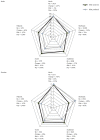Trends and predictions for gastric cancer mortality in Brazil
- PMID: 27605887
- PMCID: PMC4968132
- DOI: 10.3748/wjg.v22.i28.6527
Trends and predictions for gastric cancer mortality in Brazil
Abstract
Aim: To analyze the effect of age-period and birth cohort on gastric cancer mortality, in Brazil and across its five geographic regions, by sex, in the population over 20 years of age, as well as make projections for the period 2010-2029.
Methods: An ecological study is presented herein, which distributed gastric cancer-related deaths in Brazil and its geographic regions. The effects of age-period and birth cohort were calculated by the Poisson regression model and projections were made with the age-period-cohort model in the statistical program R.
Results: Progressive reduction of mortality rates was observed in the 1980's, and then higher and lower mortality rates were verified in the 2000's, for both sexes, in Brazil and for the South, Southeast and Midwest regions. A progressive decrease in mortality rates was observed for the Northeast (both sexes) and North (men only) regions within the period 1995-1999, followed by rising rates.
Conclusion: Regional differences were demonstrated in the mortality rates for gastric cancer in Brazil, and the least developed regions of the country will present increases in projected mortality rates.
Keywords: Brazil; Gastric neoplasms; Mortality; Projections.
Figures



Similar articles
-
Disparities in Epidemiological Profile of Gastric Adenocarcinoma in Selected Cities of Brazil.Asian Pac J Cancer Prev. 2019 Aug 1;20(8):2253-2258. doi: 10.31557/APJCP.2019.20.8.2253. Asian Pac J Cancer Prev. 2019. PMID: 31450892 Free PMC article.
-
Inequalities in esophageal cancer mortality in Brazil: Temporal trends and projections.PLoS One. 2018 Mar 19;13(3):e0193135. doi: 10.1371/journal.pone.0193135. eCollection 2018. PLoS One. 2018. PMID: 29554098 Free PMC article.
-
Colorectal cancer mortality in Brazil: predictions until the year 2025 and cancer control implications.Dis Colon Rectum. 2014 Sep;57(9):1082-9. doi: 10.1097/DCR.0000000000000186. Dis Colon Rectum. 2014. PMID: 25101604
-
[Trends in the mortality from stomach tumors in Italy from 1951 to 1981].Ann Ig. 1989 Jan-Apr;1(1-2):109-24. Ann Ig. 1989. PMID: 2483058 Review. Italian.
-
[Non-communicable chronic diseases in Brazil: from risk factors to social impact].Bol Oficina Sanit Panam. 1996 May;120(5):389-413. Bol Oficina Sanit Panam. 1996. PMID: 8924219 Review. Portuguese.
Cited by
-
Unequal burden of mortality from gastric cancer in Brazil and its regions, 2000-2015.Gastric Cancer. 2019 Jul;22(4):675-683. doi: 10.1007/s10120-018-00916-6. Epub 2019 Jan 2. Gastric Cancer. 2019. PMID: 30603910
-
Survival and prognosis of young adults with gastric cancer.Clinics (Sao Paulo). 2018 Sep 21;73(suppl 1):e651s. doi: 10.6061/clinics/2018/e651s. Clinics (Sao Paulo). 2018. PMID: 30281703 Free PMC article.
-
Temporal trends and spatial clusters of gastric cancer mortality in Brazil.Rev Panam Salud Publica. 2022 Aug 18;46:e101. doi: 10.26633/RPSP.2022.101. eCollection 2022. Rev Panam Salud Publica. 2022. PMID: 36016835 Free PMC article.
-
Are the Temporal Trends of Stomach Cancer Mortality in Brazil Similar to the Low, Middle, and High-Income Countries?Front Public Health. 2021 Jun 29;9:677012. doi: 10.3389/fpubh.2021.677012. eCollection 2021. Front Public Health. 2021. PMID: 34268288 Free PMC article. No abstract available.
-
Disparities in Epidemiological Profile of Gastric Adenocarcinoma in Selected Cities of Brazil.Asian Pac J Cancer Prev. 2019 Aug 1;20(8):2253-2258. doi: 10.31557/APJCP.2019.20.8.2253. Asian Pac J Cancer Prev. 2019. PMID: 31450892 Free PMC article.
References
-
- Ferlay J, Soerjomataram I, Dikshit R, Eser S, Mathers C, Rebelo M, Parkin DM, Forman D, Bray F. Cancer incidence and mortality worldwide: sources, methods and major patterns in GLOBOCAN 2012. Int J Cancer. 2015;136:E359–E386. - PubMed
-
- Ferlay J, Shin HR, Bray F, Forman D, Mathers C, Parkin DM. Estimates of worldwide burden of cancer in 2008: GLOBOCAN 2008. Int J Cancer. 2010;127:2893–2917. - PubMed
-
- Compare D, Rocco A, Nardone G. Risk factors in gastric cancer. Eur Rev Med Pharmacol Sci. 2010;14:302–308. - PubMed
-
- Matsuzaka M, Fukuda S, Takahashi I, Shimaya S, Oyama T, Yaegaki M, Shimoyama T, Sakamoto J, Nakaji S, Umeda T. The decreasing burden of gastric cancer in Japan. Tohoku J Exp Med. 2007;212:207–219. - PubMed
Publication types
MeSH terms
LinkOut - more resources
Full Text Sources
Other Literature Sources
Medical

